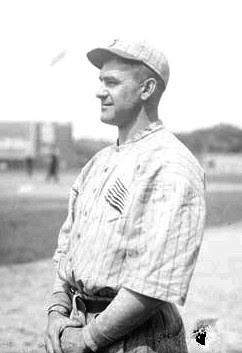Anyone who thought pennant fever in Brooklyn would subside when fans returned to work on Monday was in for a rude awakening, especially those who assumed there was no rush to get to the ball park for the doubleheader against Chicago. William Granger of the Brooklyn Citizen admitted that the Jewish New Year accounted for some of the crowd, but even so, for the fire department to close the gates on a Monday was "something brand new in baseball." When the gates were shut around 2:00, a large crowd was still milling around Ebbets Field, growing by the hundreds with the arrival of each trolley car. Nor was mass transit the sole means of access. There were so many cars parked for blocks around the ballpark, Granger thought it looked like "all the automobiles in Greater New York were at Ebbets Field." Among those still outside the ballpark were both Charles Ebbets, Sr and Jr., accompanied by the local district attorney. Reportedly it took "some wild telephoning from a nearby candy store" before the three gained admittance. Once they finally got inside some fans grabbed the senior Ebbets' straw hat and threw it on the field in anticipation of a another day of boisterous celebration. Total attendance was estimated at 26,000, the third consecutive crowd over 25,000 doubtless bringing a lump to Ebbets throat not to mention his wallet.
As optimistic as the fans may have been, their team faced a major challenge in the first game against Grover Cleveland Alexander who had already beaten Brooklyn four times in 1920. After the Cubs scored once in the top of the first, Jimmy Johnston blasted a triple only to be thrown out trying to stretch it into an inside the park home run. Although it was a missed opportunity, Johnston's hit was a sign that Alexander might be vulnerable and the Dodgers took advantage in their half of the second. Zack Wheat walked and then raced home with the tying run on Hi Myers triple. Myers scored on Pete Kilduff single and the Brooklyn second baseman soon scored himself, giving Brooklyn a 3-1 lead. After retiring Chicago without run in the third, Jeff Pfeffer helped his own cause with an RBI single and kept the Cubs at bay until the ninth. Brooklyn added two more in the bottom of the fifth, keyed by a triple by Wheat that knocked Alexander out of the game. The Dodgers added another run in the eighth and Brooklyn prevailed 7-3.
Not every play worked out for Brooklyn, here the Dodgers' first game, second inning rally ends when Ernie Krueger is tagged out by Grover Cleveland Alexander, trying to score on Ivy Olson's foul out. Brooklyn Daily Eagle - September 14, 1920
Rube Marquard started the second contest for Brooklyn and got in trouble almost immediately when Max Flack doubled with one out. Next up was Dave Robertson who hit a grounder that looked like a hit until Pete Kilduff made a "circus stop." Ray Schmandt took Kilduff's throw at first to retire Robertson and then threw Flack out at home to complete a sensational double play. Having dodged that bullet, the Dodgers quickly got on the scoreboard when Ivy Olson tripled in the bottom of the first and scored on Jimmy Johnston's single. Brooklyn added two more runs, but Marquard, who Tom Rice of the Eagle felt had a "feeble look," gave up two runs in the fourth. Wilbert Robinson removed Marquard for a pinch hitter in the bottom of the inning and the Dodgers got the two tallies back. Al Mamaux took over on the mound and pitched five shutout innings, but incredibly did not get the win. According to the rules of the day, the official scorer decided who deserved the win which in this case went to Marquard. Although Rice disagreed with the decision, he took a philosophical approach, doubtless because the official scorer was his boss, Abe Yager.
Brooklyn Daily Eagle - October 4, 1920
The Dodgers coasted to a 7-2 win behind timely hitting and what Rice called their "snappy defense." Not about to give up their new found way of celebrating, fans responded to a Zack Wheat catch with another shower of straw hats. To make the day even more rewarding, the Reds lost again, this time to Philadelphia and trailed Brooklyn by five full games with less than three weeks to play. Although the Giants defeated the Cards, they too were five back and it's no wonder, Rice claimed Brooklyn had "just about" clinched the 1920 National League pennant. The other two teams hopes hinged on the Dodgers losing some games and the Brooklyn club refused to cooperate. The Dodgers went 10-4 the rest of the way and clinched the pennant on September 27th. All told, Brooklyn went 23-6 over the last month of the season, an almost .800 winning percentage. Not only had the Dodgers won the pennant, they made Eagle sports editor, Abe Yager, a prophet, coming only one game short of his prediction the club would win 94 games. Now, however, Brooklyn fans were concerned about another set of predictions - forecasts of how their Dodgers would fare against the Cleveland Indians in the 1920 World Series.


















